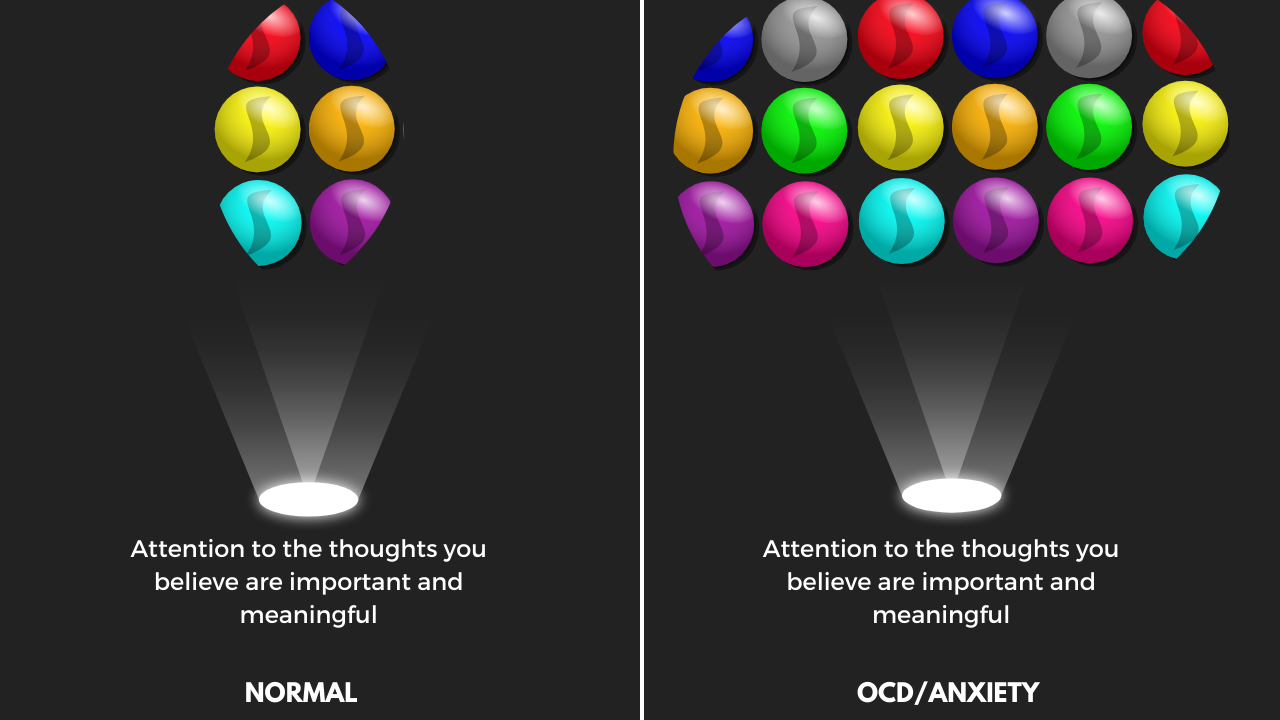The Four Step Method to Managing OCD
Obsessive Compulsive Disorder (OCD) is a type of anxiety disorder where individuals experience intrusive and unwanted thoughts (or images) followed by compulsive behaviors that attempt to reduce the anxiety and distress. It's a hamster wheel of intrusive thoughts, distress, and compulsions. Unfortunately, the compulsive behaviors never quite satisfy.

I was diagnosed with obsessive compulsive disorder (OCD) when I was about 14 years old. I often tell my patients that OCD is like the Tourette’s Disorder of thinking, but instead of blurting out a sound, disturbing thoughts are blurted out in the mind. Most people will experience intrusive thoughts from time to time but are able to quickly shrug them off. The problem occurs when we attach significance to disturbing thoughts, believing they mean something about us.
The figure of marbles illustrates this point.

The marbles represent all the thoughts and sensations we experience, and the spotlight represents the focus of our attention. Normally, we filter the thoughts and sensations we experience and only direct our attention to those that are truly meaningful and important. However, those with obsessive compulsive disorder (and other anxiety disorders) place significance on nearly every thought and sensation we experience. This is because the "alarm system" is constantly signaling that "something is wrong."
Am I a murderer for having the intrusive thought about killing my dog?
No. You're not.
Taking personal responsibility for intrusive thoughts doesn’t make sense because they can occur without our consent. Unfortunately, many of us, especially those of us struggling with OCD, often feel responsible for things that are beyond our immediate control, like our thoughts. And that leads to feeling shame, guilt, doubt, fear, and most notably, disgust. It's difficult to be mentally present to experience life’s joys when your attention is constantly being hijacked and directed to the thoughts that you believe are significant. It's also an exhausting existence.
If you are struggling with OCD symptoms, know that what you're experiencing is not a reflection of you—it’s a reflection of how OCD operates in your brain.
You are not alone in this.
The 4 Step Method
One approach I highly recommend is the 4-Step Method developed by Dr. Jeffrey Schwartz at UCLA. This method helps you respond differently to obsessive thoughts and compulsive urges by training your brain to not react on autopilot. This is how it works:
1. Relabel
Start by calling the intrusive worry/thought/urge what it is: a symptom of Obsessive compulsive disorder. Instead of thinking and saying “I feel like something’s wrong with my body,” try replacing that with “This is just my OCD brain making me think something is wrong.” Relabeling helps create space between you and the thought so you're not immediately caught up in it.
2. Reattribute
Remind yourself “This thought is coming from a glitch in my brain.” It's not a real signal of danger. It's a false alarm caused by a temporary misfiring in the brain's fear circuits. This step helps you resist the urge to respond as if the thought is meaningful or urgent.
3. Refocus
Shift your attention to something else for at least 5-10 minutes—even if it's just one minute at first. You might go for a walk, text a friend, do a puzzle, or engage in any activity that helps redirect your attention. This trains your brain to weaken the OCD circuits and strengthen healthier ones.
4. Revalue
Over time, as you practice the first three steps, you start to internalize the truth: the OCD thought has no value. It's just noise. It doesn’t define you, and it doesn't deserve your attention. This step helps reduce the emotional power OCD has over you.
Practice these steps gently and consistently. You will stumble through it for a while but that is okay. The goal isn't perfection nor is it to get rid of the thoughts immediately—it's to change your relationship with them.
If interested in learning more, I highly recommend the book Brain Lock by Jeffery Schwartz, MD.
This post was reviewed by a licensed mental health professional.
